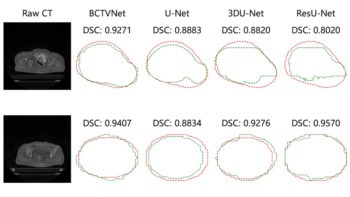The next time you step on bathroom scales, remember that it’s not your big bone structure or that extra helping of pudding that makes you heavy, it’s the motion of the quarks and gluons buzzing around inside the protons and neutrons that make up your body.
That’s the finding of a massive computer simulation of quantum chromodynamics (QCD) — the theory of the strong force — carried out by researchers in Germany, Hungary and France. They say theirs is the first to control all systematic uncertainties, thereby providing an accurate description of how quarks bind together to form baryons such as protons and neutrons.
The idea that protons and neutrons are made of three quarks has been around for over 40 years. However, the mathematical nature of the strong force that binds quarks together makes it impossible to make exact analytic calculations of the fundamental properties of both the quarks and the particles they make up.
Sea of quarks
This is further complicated by the “sea” of quark–antiquark pairs that is also believed to reside within heavy particles. These pairs bubble up from the gluons — massless particles that mediate the strong force — and must be included in any credible calculation.
To overcome these problems, physicists have come up with clever ways of doing approximate QCD calculations using supercomputers. But despite the development of sophisticated numerical techniques and ever faster computers, physicists have struggled to make a reasonable prediction of the mass of the humble proton — a quantity that is known experimentally to great precision.
Now, Zoltan Fodor and colleagues at DESY, Bergische University and the Juelich Supercomputing Center in Germany, along with researchers at Eotvos University in Hungary and CNRS Aix-Marseille in France, have used an established computational technique called “lattice gauge theory” to make the first calculations of the masses of the proton and neutron that incorporate all the relevant physics; make all the appropriate numerical approximations; and deliver a comprehensive analysis of possible errors and uncertainties in the results. Their success was possible thanks to the combined power of two IBM Blue Gene supercomputers and two cluster-computing centres (Science 322 1224).
4D lattice does the trick
The technique keeps track of a vast number of quarks and gluons by describing the space and time inside a proton with a set of points that make up a 4D lattice. This allows the equations of QCD to be solved in an iterative process using standard numerical techniques.
The problem is that this discretization introduces systematic errors. Although those errors can be controlled by making the lattice spacing smaller, that in turn requires even more computing power. The approximation also had to keep track of the sea quarks, which is another computationally intensive task.
The calculations suggest that the mass of the nucleon (the calculation cannot distinguish between protons and neutrons) to be 936 MeV/C2 with statistical and systematic uncertainties of ±25 and ±22 MeV/C2 respectively. The known mass of the proton and neutron are 938 and 940 MeV/C2 respectively.
The team has also been able to use the technique to calculate the mass of two mesons and seven heavier baryons.
Separating weak from strong
While calculating the mass of the proton hardly seems Earth shattering, Fodor believes that the team’s work shows that it is possible to make meaningful predictions of the role of the strong force in the particle interactions that will soon be occurring in the LHC.
For example, CP violation is usually associated with the weak force between quarks, but quarks always interact strongly, thus the strong force must also be considered. The LHCb experiment at the LHC is intended to explore such CP violating processes or even new physical phenomena and interpreting its results will require accurate calculations of the properties of particles containing the bottom quark.
On a more philosophical note, Fodor points out that the calculations confirm that the QCD-driven motion of quarks within nucleons — rather than the mass of the quarks themselves — is responsible for the vast majority of the visible mass in the universe.



